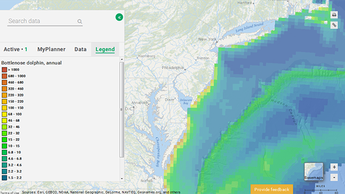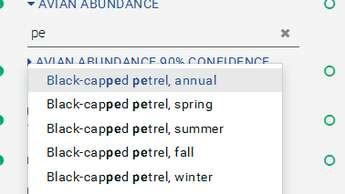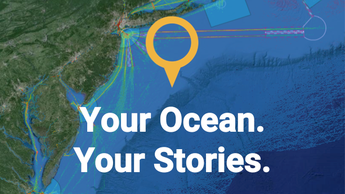Explore Thousands of Maps for Birds, Fish & Mammals in the Marine Life Library
One of the largest online collections of marine life maps in the world is now available on the Mid-Atlantic Ocean Data Portal.
Roughly 3,000 maps showing populations and abundance for individual species of fish, birds and mammals along the East Coast have been added to the Portal’s new searchable Marine Life Library. The data were aggregated over the course of two years by a Marine Life and Data Analysis Team (MDAT) in collaboration with the Mid-Atlantic and Northeast Regional Planning Bodies.
Due to the sheer volume of data, the Portal Team developed a search tool specifically for the Marine Life Library that allows users to type in part of a species name to produce a list of relevant results.
The following is a quick start guide for using the Marine
Life Library.

How to Use the Marine Life Library
- Click on the Marine Life Library theme in Marine Planner’s Data tab.
- Click on one of the 13 available datasets related to fish, marine mammals or birds. (See below for an explanation of these options.) A search field will appear beneath the heading.
- Type in a species name or other identifier. After typing in two characters, you will begin to see a list of potential results. (NOTE: Only 12 results are presented at a time. To refine your results, continue typing characters until the specific data you’re looking for appears. For example, if searching for Atlantic sturgeon, the “st” may initially show striped anchovy or striped bass data, but “stu” will begin to return sturgeon results. Likewise, typing in a term such as “whales” will return results for beaked whales, fin whales, etc. If looking for a species such as humpback whales, try starting with “hu …”)
- Select a map layer. Once activated, these maps will function
as any other on Marine Planner. (NOTE: Bookmarks and sharable URLs will not work for these map layers.)

About the Datasets
The Marine Life Library currently offers 13 searchable datasets that predict species abundance (number of animals in a given area), occurrence (probability of a species being in an area) and, for fish, biomass (measured weight of organisms in an area) based on past observations. For the birds and marine mammals, overview maps that predict occurrence or abundance based on several years of data are provided, along with supplemental datasets that show the uncertainty associated with modeled data.
Below are brief overviews of the datasets. Users can visit the MDAT abstract and metadata page for more detailed explanations.
Avian Abundance: The long-term average abundance of individual species in an area based on data from 1978-2014. Two supplemental datasets for interpreting the data — Avian Abundance 90% Confidence Interval and Avian Abundance Coefficient of Variation — are provided.
Avian Occurrence: Average probability of occurrence of individual species based on data from 1978-2014. Two supplemental datasets for interpreting the information — Avian Occurrence 90% Confidence Interval and Avian Occurrence Coefficient of Variation — are provided.
Fish Biomass NEFSC Species: Individual species maps based on fall bottom trawl survey data collected by the NOAA Northeast Fisheries Science Center (NEFSC) from 1970-2014.
Fish Biomass NEAMAP Species: Individual species maps based on fall bottom trawl survey data collected by the North East Area Monitoring and Assessment Program (NEAMAP) from 2007-14.
Marine Mammal Abundance: The long-term average abundance of individual species modeled from sightings from 1992 through 2014. Four supplemental datasets for interpreting the information – Marine Mammal 5th Percentile, 95th Percentile, Coefficient of Variation and Standard Error – are provided.
The publication of these individual species maps’ follows
the release of an
initial set of over 100 summary maps based on the MDAT data. Those maps
grouped together multiple individual species with common characteristics to
provide simple snapshots of each group’s abundance, core areas and species
richness. For example, Coastal Waterfowl maps include data for various scoters,
ducks, loons and eiders.
Questions or Comments?

Do you have any questions about the Marine Life Library? Suggestions for how we might improve it? Send us an email at portal@midatlanticocean.org or tweet us at @PortalMARCO.
Share this story